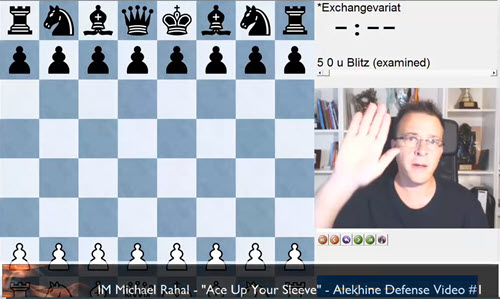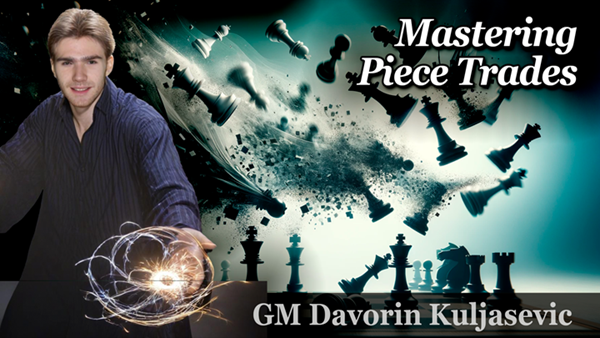Opening: :
Player(s):
Bishop Pair advantage: from simple tactics to mastering the endgame.
Most chess players know, thank to the study of master games, that two bishops are stronger than two knights or than bishop and knight. However, very few know the reasons of this advantage and how to turn it into account. There are many situations where pieces of similar stature perform differently.
Capablanca said: " When your opponent has a bishop you usually have to put your pawns on the squares with the same color of this bishop's square. On the contrary, when you have a bishop, you have to put your pawns on the squares of the opposite color of the bishop's squares, no matter if your opponent has a bishop or not."
If most of your pawns (particularly the central pawns) are on the same color squares as one of your bishops, that bishop is considered a "bad" bishop.
Similarly, a bishop that does not share the same squares color as most of your pawns is considered a "good" bishop. Why is that so? Because this 'color configuration' allows the player to control squares of both colors; allows the bishop to move freely among the pawns, and helps fix enemy pawns on squares on which they can be attacked by the bishop. Such a bishop is often referred to as a "good" bishop.
Good bishops are often more advantageous than bad ones. Good bishops have more freedom of movement, and control squares that their allied pawns cannot. On the other hand, "bad" bishops can sometimes be useful, as they and their pawns can defend each other.
Even when most of your pawns (particularly the central pawns) are on the same color squares as one of your bishops and your bishop is outside of its pawn chain, that is an active bishop!
Active bishops have greater freedom and are generally better placed than those still trapped inside the pawn chain.
Don't miss this new and formative series by our GM Boris Alterman!
This is a 5 minute preview.
Log in to watch the full show or click one of the links below.
Page 1 of 92 pages 1 2 3 > Last ›

Added on 07.26.2024
GM Miguel Illescas - Top 10 Checkmate Patterns - Video 17

Added on 07.24.2024
D15 GM Kuljasevic’s “Mastering Closed Position”- Deep Maneuvering

Added on 07.22.2024
IM Rahal Ace up Your Sleeve for Black - Part 5

Added on 07.19.2024
GM Miguel Illescas - Top 10 Checkmate Patterns - Video 16

Added on 07.17.2024
C98 GM Kuljasevic’s “Mastering Closed Position”- Python Squeeze

Added on 07.15.2024
IM Rahal Ace up Your Sleeve for Black - Part 4

Added on 07.12.2024
GM Miguel Illescas - Top 10 Checkmate Patterns - Video 15

Added on 07.10.2024
E74, E29 GM Kuljasevic’s “Mastering Closed Position”- Play on both wings

Added on 07.08.2024
IM Rahal Ace up Your Sleeve for Black - Part 3

Added on 07.05.2024
D26 GM Miguel Illescas - Top 10 Checkmate Patterns - Video 14

Added on 07.03.2024
C01, A09 GM Kuljasevic’s “Mastering Closed Position”- Open Files

Added on 07.01.2024
IM Rahal Ace up Your Sleeve for Black - Part 2

Added on 06.28.2024
GM Miguel Illescas - Top 10 Checkmate Patterns - Video 13

Added on 06.26.2024
E45, E94 GM Kuljasevic’s “Mastering Closed Position”- Semi-open Files

Added on 06.24.2024
IM Rahal Ace up Your Sleeve for Black - Part 1

Added on 06.21.2024
GM Miguel Illescas - Top 10 Checkmate Patterns - Video 12

Added on 06.19.2024
B11, D41 GM Kuljasevic’s “Mastering Closed Position”- Outpost

Added on 06.17.2024
B20 IM Rahal Ace up Your Sleeve - Sicilian Morra Gambit 2

Added on 06.14.2024
GM Miguel Illescas - Top 10 Checkmate Patterns - Video 11

Added on 06.12.2024
E80, C77 GM Kuljasevic’s “Mastering Closed Position”- Breakthrough

Added on 06.10.2024
B20 IM Rahal Ace up Your Sleeve - Sicilian Morra Gambit - Part 1

Added on 06.07.2024
GM Miguel Illescas - Top 10 Checkmate Patterns - Part 10

Added on 06.05.2024
A08, E94 GM Kuljasevic’s “Mastering Closed Position”- Prophylactic Thinking

Added on 06.03.2024
B01 IM Rahal Ace up Your Sleeve - Scandinavian Inverted Budapest Gambit Part 2

Added on 05.31.2024
GM Miguel Illescas - Top 10 Checkmate Patterns - Part 9

Added on 05.29.2024
GM Kuljasevic’s “Mastering Closed Position”- Schematic Thinking - Part 2

Added on 05.27.2024
B01 IM Rahal Ace up Your Sleeve - Scandinavian Inverted Budapest Gambit Part 1

Added on 05.24.2024
GM Miguel Illescas - Top 10 Checkmate Patterns - Part 8

Added on 05.22.2024
E28, C19 GM Kuljasevic’s “Mastering Closed Position”- Schematic Thinking - Part 1

Added on 05.20.2024
C84 IM Rahal Ace up Your Sleeve - Ruy Lopez Centre Attack - Part 1

Added on 05.17.2024
GM Miguel Illescas - Top 10 Checkmate Patterns - Part 7

Added on 05.15.2024
GM Kuljasevic’s “Mastering Closed Position” - Introduction

Added on 05.13.2024
IM Michael Rahal Ace up Your Sleeve - Austrian Attack Part 2

Added on 05.10.2024
GM Miguel Illescas - Top 10 Checkmate Patterns - Part 6

Added on 05.06.2024
B09 IM Michael Rahal Ace up Your Sleeve - Austrian Attack Part 1

Added on 05.03.2024
GM Miguel Illescas - Top 10 Checkmate Patterns - Part 5

Added on 04.29.2024
B00 IM Rahal Ace up Your Sleeve - Nimzowitsch Defense - Part 2

Added on 04.26.2024
GM Miguel Illescas - Top 10 Checkmate Patterns - Part 4

Added on 04.24.2024
GM Davorin Kuljasevic - Mastering Piece Trades - Video 10

Added on 04.22.2024
B00 IM Rahal Ace up Your Sleeve - Nimzowitsch Defense - Part 1

Added on 04.19.2024
E46, A09 GM Miguel Illescas - Top 10 Checkmate Patterns - Part 3

Added on 04.17.2024
GM Davorin Kuljasevic - Mastering Piece Trades - Video 9

Added on 04.15.2024
C00 IM Rahal Ace up Your Sleeve - French Wing Gambit - Part 2

Added on 04.12.2024
GM Miguel Illescas - Top 10 Checkmate Patterns - Part 2

Added on 04.10.2024
GM Davorin Kuljasevic - Mastering Piece Trades - Video 8

Added on 04.08.2024
C00 IM Rahal Ace up Your Sleeve - French Wing Gambit - Part 1

Added on 04.05.2024
A80, A00, C20 GM Miguel Illescas - Top 10 Checkmate Patterns - Part 1

Added on 04.03.2024
GM Davorin Kuljasevic - Mastering Piece Trades - Video 7